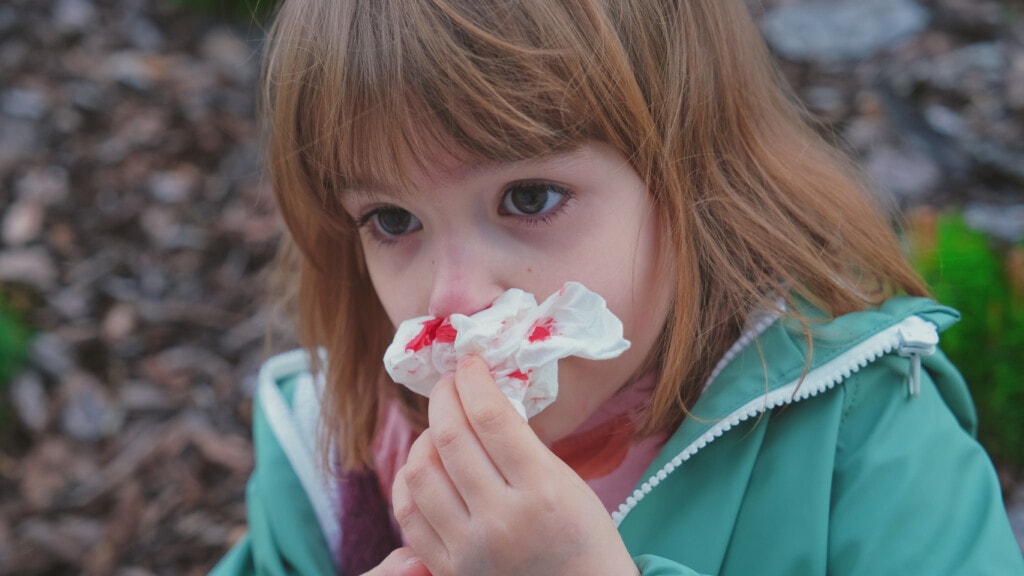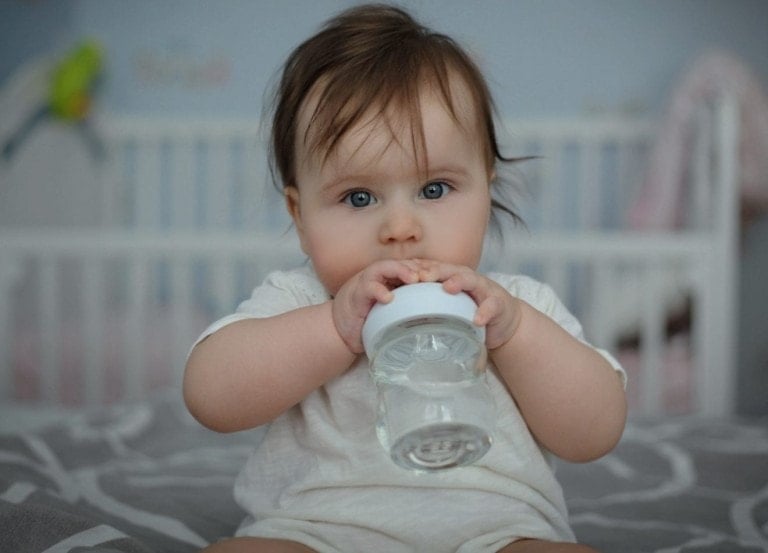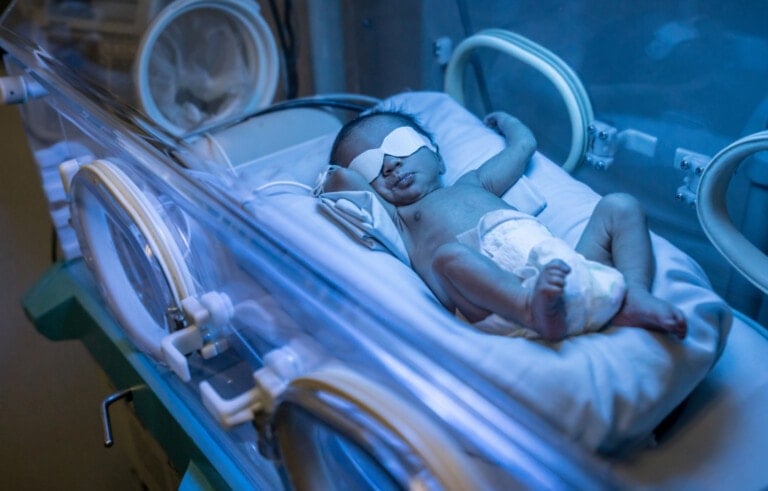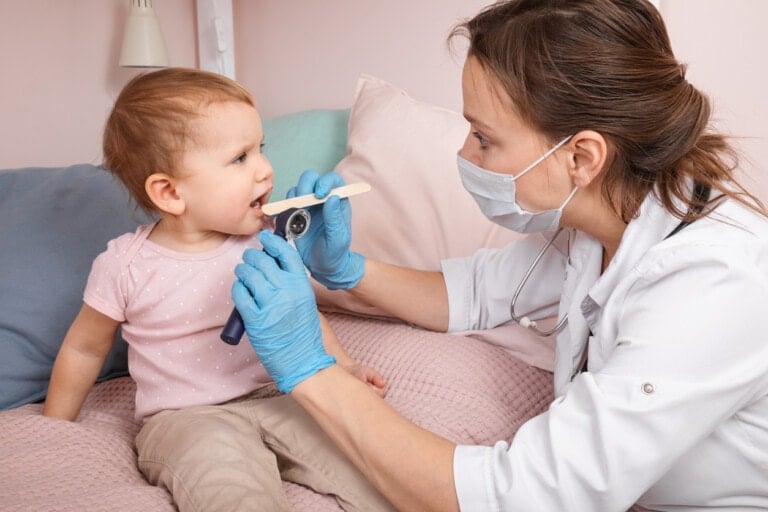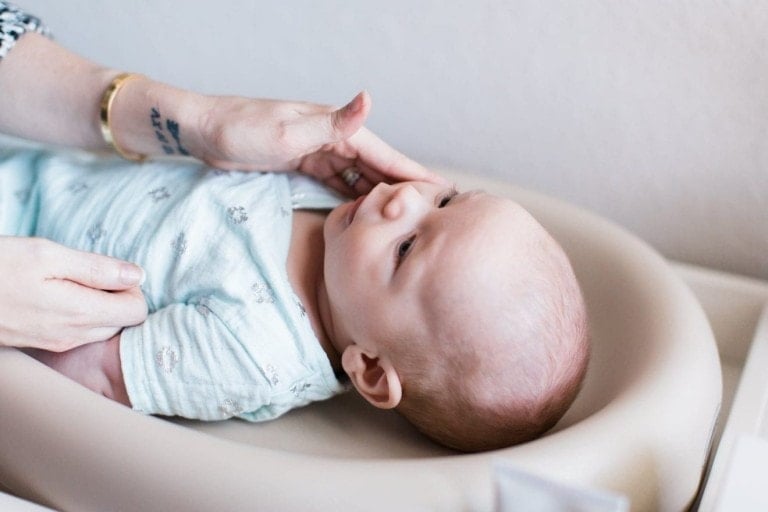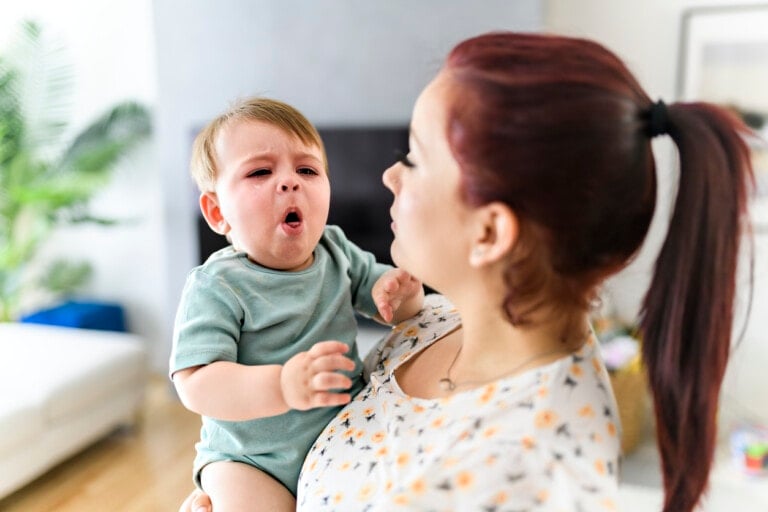The dreaded bloody nose in kids. Nosebleeds in kids can be alarming and messy, causing stress among children and caregivers. While trying to keep the mess at bay, you may also wonder what causes your child to have a bloody nose. This article will help you understand why they are happening, how to stop and prevent them, and when to worry about a nosebleed.
What is a Nosebleed?
The medical term for a nosebleed is epistaxis, which refers to bleeding from one or both nostrils. Typically the bleeding comes from the front inner wall of the nasal septum or the wall dividing the nostrils. Many tiny blood vessels are located just under the surface of this wall. Because these blood vessels are superficial, they are particularly vulnerable to irritation, injury, and trauma.1,2
More than half of children will experience at least one bloody nose by age 10, making them a very common childhood experience. Nosebleeds in kids can be a one-off experience, or they can be recurrent. Most doctors consider them recurrent if they happen five or more times yearly.1
What Causes a Bloody Nose?
Although the appearance of a bloody nose in kids can be worrisome, they are usually benign. This means most are not due to any underlying cause or disease. The most common reasons for a bloody nose in kids include nose picking and dry air, which causes a dry nose.1,2
Nosebleeds can also be caused by swelling or infection in the nasal passages and sinuses. This often happens when your child has a cold or seasonal allergies. Medications such as aspirin, blood thinners, and overuse of nasal sprays can also contribute to nosebleeds. Underlying disorders such as clotting disorders, tumors, polyps, and leukemia are possible but not common causes of nosebleeds in kids.2
How To Stop a Bloody Nose
Stopping a nosebleed requires getting the blood to clot. You can encourage this in several ways.
Apply Pressure to Bloody Nose
Hold constant, firm pressure to the bottom third of the nose for at least five minutes straight. This pressure will decrease new blood flow to the area and cause blood to pool and clot. Be sure to pinch the nose’s soft part and not the nose’s bridge. Imagine the child is preparing to jump into a pool. Do not release the pressure to check the bleeding for at least five to 10 consecutive minutes.1
You can use a tissue to apply pressure to the outside of the nose and catch the blood that seeps through your pinching. However, you should avoid packing the inside of the nostrils with tissues, cotton, or any other foreign material. This can cause more trauma to the nasal wall and worsen bleeding.3
Use Ice To Slow a Bloody Nose
Ice causes blood vessels to tighten, allowing less blood to pass through. This can decrease the blood flow and encourage clotting, thereby stopping a bloody nose.4
Applying a bag of frozen peas, an ice pack, or a cold compress to the nose can be an excellent way to stop a nosebleed.
Change Their Posture
Just as you elevate any other wound to decrease swelling and bleeding, it is best to remain upright during a bloody nose. Have your child sit or stand, but do not lay them down. Keeping the nose above the heart makes it slightly harder for excess blood to reach the nose.3,4
In addition to keeping your child upright while their nose is bleeding, it is essential to tilt the child’s chin slightly down and forehead forward. This prevents blood from running down the back of the throat and decreases the risk of choking on or swallowing blood.3,4
Consider Medication
Nasal decongestant sprays like oxymetazoline and phenylephrine cause blood vessels in the nose to constrict and can sometimes be successful at stopping the bleeding when administered during a nosebleed. However, these medications have certain age restrictions and risks. Read the label and talk to your child’s pediatrician before administering medications.4
How To Prevent and Treat a Bloody Nose in Kids
Here are some ways to prevent nosebleeds in kids.
Discourage Nose-Picking
Since nose-picking is the most common cause of nosebleeds in kids, try discouraging your child from digging in their nose. If your child is old enough to understand cause and effect, you can explain that this habit contributes to their experience of a bloody nose. Hopefully, this will motivate them to stop!
If you cannot get your child to stop picking their nose, keep their nails short and filed to decrease their chances of injuring the nasal wall.
Humidify Your Air
Dry air can cause a dry nose, and a dry nose is more susceptible to a bloody nose. Therefore, try to humidify the air. Humidifiers can be used in your child’s bedroom to moisten their nose while they sleep. You can also look into a whole-house humidifier. This can be particularly useful in the winter months when heated indoor air is especially dry.3
Topical Moisturization
You can try applying petroleum jelly to the lower inner nostril wall to help heal the areas of dryness and prevent future nosebleeds. If this is a recurrent problem, you can ask their pediatrician about a medicated ointment.5
Oral Hydration
Make sure your child is drinking plenty of water. This will help keep nasal passages moist, preventing excessive dry noses in kids, thereby decreasing the occurrence of nosebleeds.6
Examine Your Child’s Medications
If your child takes any regular medications, examine the labels for side effects of a bloody nose. If dry nose or nosebleeds are side effects of your child’s medication, talk to their provider about alternatives.
Cauterize the Nose
If all other efforts fail to decrease nosebleeds in your child, your doctor may recommend cauterization. This is when a chemical or a device is applied inside the nose to prevent future instances of bleeding.7
When To Worry About a Nosebleed
If you have noticed an uptick in the frequency or intensity of your child’s nosebleeds, this is worth mentioning to their primary care provider. You should also mention any bloody noses to your child’s doctor if they are younger than two.
Seek emergency attention if your child’s nosebleed lasts longer than 30 minutes without stopping, involves a great deal of blood, interferes with their ability to breathe, or is the result of an injury such as a car accident.2
Fortunately, there is not much need to worry about in most bloody nose cases. They are a common issue in childhood due to nose picking and dry air. However, knowing how to manage, prevent, and treat nosebleeds when they arise and when to worry about them is still helpful. Always reach out to your pediatrician with concerns regarding your child’s health, and keep these tips and tricks in your back pocket to stop your little one’s next nosebleed.













